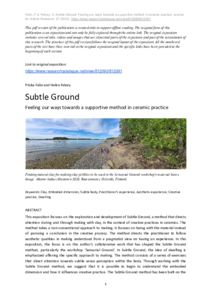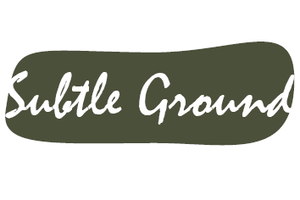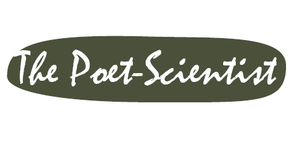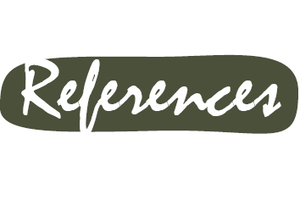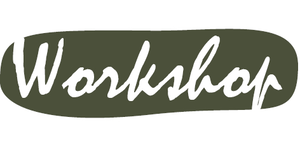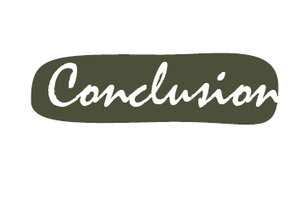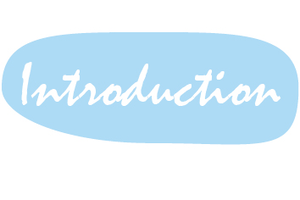Practice
In this research, we focus on ceramics practice. By practice, we mean that something has been sustained over a period of time, through which a connection is established between the maker and her material.
Making
In this exposition, when discussing making, we are referring to the physical activity with the clay. Whilst there are many different forms of making with clay, here, the emphasis is on the bodily engagement with the material instead of what is being produced.
Finding natural clay for making clay pebbles, to be used in the Sensorial Ground workshop's material boxes. Image: Manne-Sakari Mustonen 2020, Ramsinniemi, Helsinki, Finland.
This exposition presents parts of our artistic research that is an ongoing collaboration between two countries. We are two artists working through a material-based dialogue that draws from our practice and shared interests. We have been developing an exploration of clay as a material that grounds our bodies and creates a connection to the surrounding environment. In this exposition, when seeking to understand clay as supportive material, we look into the therapeutic qualities of clay demonstrated by research within the fields of art therapy and psychotherapy. We also consider how ceramic practitioners draw connections between making and meditation practices. In both cases, we recognize the grounding and vitalizing aspects of clay work.
For the basis of our work, we introduce two workshops where we began to develop a direction within a creative practice that uses clay work as a means to focus on the experiential aspects of making. The outcomes of the workshops are developed further in this exposition to form a method that draws upon the experiential aspects of making and is tightly connected to the creative practice. We also discuss the shared research that was used to formulate the structure and aims for the ‘Sensorial Ground’ workshop. Our work is a continuous journey exploring the clay’s possibilities, and in this context, we discuss the clay and its qualities that we find relevant and enable the practice that is sought through the Subtle Ground method.
As ceramic practitioners, we draw upon personal experiences. Through sustained conversation and shared practice, we have explored exercises that extend towards the environment in order to gain an open perceptive state of being before working with the clay. In our conversation, we weaved together our practice and theoretical interests and examined the areas of overlap and the gaps that needed more discovery. We began to discuss our early embodied experiences from our nature that we remember in our childhood. These embodied memories led to new realizations in the research. While beginning to explore through our practice, we found a strong connection to Miller’s edition of Goethe’s Metamorphosis of Plants (2009). From this edition, we drew the idea of a Poet–Scientist to guide our paths when seeking the embodied relatedness within our material work.
The Subtle Ground supports and upholds a ceramic practitioner’s engagement towards her practice. The method aims to direct attention to the subtle level of sensing bringing the aesthetic nature of the material practice to the forefront. Our method comprises a series of exercises that bring attention to sense perception and the embodied dimension as an integral part of making processes. The activities described in this exposition seek to utilize a practitioner’s intrinsic qualities and personal connections towards material and environment in a way that enables them to bring their focus towards within.
In the Subtle Ground method, we connect to the practitioners’ existing dimensions of practice alongside initiating a process of self-discovery through the clay. The foundation is in the unity of the body–mind following the embodied cognition theories. Philosopher Mark Johnson states: ‘Acknowledging that every aspect of human being is grounded in specific forms of bodily engagement with an environment requires a far-reaching rethinking of who and what we are, in a way that is largely at odds with many of our inherited Western philosophical and religious traditions’ (2007: 1). Here, we draw upon meditation and the eastern philosophies of making. Such material has nurtured our dialogue into body–mind unity and has supported our approach to materials and processes.
In this research, we employ the term ‘subtle body’, which we use to refer to reaching towards the subtler experiences within the body to become more body-aware during creative practice. For the purpose of this discussion, the term enables us to focus on the body's ability to perceive the nuances and details within the material world.
In current theoretical discussions on making activities, which have a close or direct connection to the material, the articulation of embodied knowledge has been located in the dialogue or negotiation between the material and the maker (Brinck and Reddy 2019; Aktaş and Mäkelä 2019). In the context of design research, embodied cognition has been central to gaining an understanding of how practitioners think with their hands (Groth 2017). Research has also shown that practising arts and crafts is tightly connected to the essence of human embodied cognition and well-being (Huotilainen, Rankanen, Groth, Seitamaa-Hakkarainen, and Mäkelä 2018). There is a wide recognition and emphasis on embodied cognition in the research that focuses on creative practice; yet, the research continues to overlook the inherent embodied capacity of the practitioner and how this can be supported.
There are some notable practices for artists, designers, and craftspersons on how to, for example, tap into their different senses and be more body-aware during practice. In her doctoral research, Ariana Amacker (2017) puts forward the novel idea of using Butoh, a movement improvisation method, for exploring perceptual and physical engagement in the design practice. In her more recent article, Amacker (2019) points to the ability to practise serendipity in the context of creative practices and draws from her training in movement improvisation. In her article, she advocates that “all forms of inquiry share a continuum between a reflective, conscious mode of awareness and an aesthetic, pre-analytic mode of awareness” (ibid.: 1843). This pre-analytic mode of inquiry corresponds to the idea of the Subtle Ground as a dimension where emotions and physicality are in the core instead of rational mind.
Artist Lotte van Gelder situates her practice in ‘the intersection of language movement and space’. In her essay ‘So This is Where We Meet’, she discusses her use of movement-based practice that she offers for students working in creative practices (van Gelder 2016). In her sessions, she places bodywork at the starting point of art and design practice and discusses the body from different perspectives. In her approach, the body can be a destination “serving as a canvas to make work on or around” (ibid.: 36). In addition to working towards the body, she describes the body as a tool where the sessions are “providing makers with an awareness of the functioning of their primary instrument” (ibid.). Gelder encourages the participants to contemplate on their personal, inner experiences and through her sessions she targets something that can only be understood through direct experiencing.
Subtle Ground aims to support practice through understanding the subtle body and how it performs during the practice, understanding the personal connections and the embodied dimension which shapes the act of making. In the following sections, we discuss a series of exercises and highlight the core elements of the method, which brings emphasis to the practitioners’ personal directions that ultimately shape the ways in which the method becomes applicable. The overall idea in the Subtle Ground relies on ‘dwelling’, which is further defined through the notion of ‘indwelling’. ‘Dwelling’ encourages the being with the material in making, while ‘indwelling’ gives direction to inhale and exhale the material qualities and processes of making.

